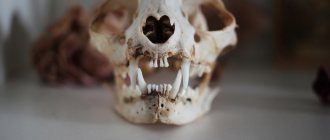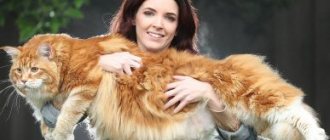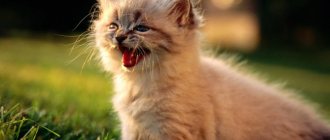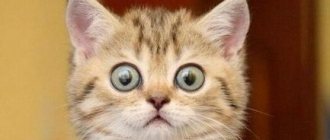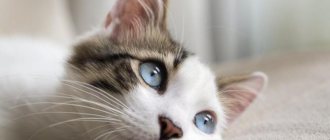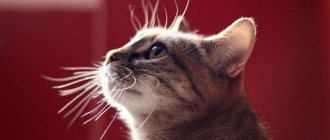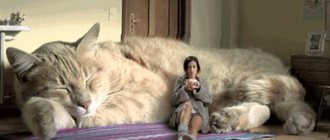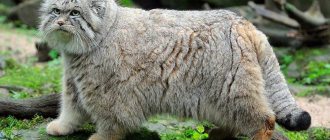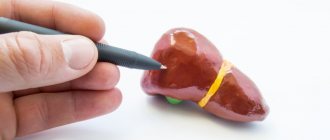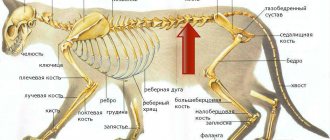The mustachioed pets captivated the ancient Egyptians with their grace and majesty, so they were revered for a long time on a par with the gods. But even now, people continue to clean out cat litter boxes and feed their pets at 6 am if they refuse to eat alone. In addition to love, the level of responsibility also increases.
The modern owner knows much more about the body of his cat than the inhabitants of Ancient Egypt, but is constantly learning something new. And this is not surprising! Some facts about anatomy are not only useful, but also so stunning that they are definitely worth sharing with your friends.
Features of the structure of cats
Cats became pets much later than dogs. Therefore, they retained the body structure characteristic of all representatives of the cat family. The length of the body of a domestic cat varies within 60 cm, and the length of the tail is 25–30 cm. The average weight of a cat is 2.5–6.5 kg, but there are also impressive specimens weighing 7–9 kg. And cats of the Siberian and Maine Coon breeds can weigh 11–13 kg. There have been cases when cats reached 20 kg, but most often the reason for this was obesity.
On average, cats weigh up to 6.5 kg, but Maine Coons and Siberians can reach a weight of 13 kg
There are 4 parts of a cat's body:
- Head. It distinguishes between the brain (cat's skull) and facial (muzzle) parts. The front part also includes the forehead, nose, ears, and teeth.
- Neck. Here the upper part and the lower region are distinguished.
- Torso. It is represented by the withers (it is formed by the first five thoracic vertebrae and the upper edges of the scapula, which are on the same level with them), back, lower back, thoracic region (chest), croup, inguinal, abdomen, area of the mammary glands and prepuce, anal region, tail.
- Limbs. Thoracic (front): shoulder, elbow, forearm, wrist, metacarpus and pelvic (posterior): thigh, knee, shin, heel, metatarsus.
General information
What is the anatomy of a cat's skeleton? As mentioned above, the animal’s body is divided into regions. In the head there is a face and a skull. The latter contains the anterosuperior part, the crown, the back of the head, the forehead, and the temple. The face is distinguished by the intermaxillary, buccal, orbital, oral, buccal and nasal regions. The cat's neck runs from the back of the head to the shoulder blade. The body is divided into a chest with a corresponding cavity and a back. The mammary glands are located on the chest. The back is divided into two vertebral regions. One is thoracic, the second is interscapular. In the last one on the left, in the area of the elbow joint, there is a cardiac part. The abdomen is divided into posterior, middle and anterior regions. The first contains the inguinal and pubic segments. The abdomen passes into the pelvic region. It includes the ischial, gluteal and sacral parts. The limbs of the animal are divided into pelvic and thoracic. The cat's toes have retractable claws. The animal steps on the lower part - the pads.
The structure of a cat's skeleton and its joints
The skeleton plays the role of a frame made of bones (a cat has about 240 of them) and has 2 sections: axial and peripheral.
The skeleton of a cat has about 240 bones
The axial section includes:
- The spine consists of 30 vertebrae, which are divided into 5 sections. The cervical vertebrae are large and allow the cat to turn its head almost 180 degrees without changing body position. The tail also belongs to the spine; it allows you to maintain good balance when jumping and falling.
The tail is part of the spine and helps maintain balance.
- The chest consists of 12 pairs of ribs.
- Cat skull. Unlike other mammals, cats have a short skull, and the size of the head in relation to the size of the entire body is small. Conventionally, the skull can be divided into 2 parts:
- facial, on which 13 bones are located;
- cranial, which contains 11 bones. The bones of the skull are stronger and larger than the facial part. The cat has a powerful jaw. Its main attribute is teeth. An adult animal has 30 of them. But even a kitten at the age of 3-4 weeks already has 26 sharp teeth. At 5–6 months, complete replacement of baby teeth with molars occurs.
Cats have shorter skulls than other mammals
The peripheral section includes the fore and hind limbs.
We all know that cats walk as if “on their toes”, without stepping on their heels completely. This is explained by the fact that the knee is located higher than we usually think - near the stomach.
There are 5 toes on each of the front paws, and 4 on the hind paws. Each toe ends in a sharp claw, hidden in a so-called pouch when at rest.
The cat only releases its claws when necessary.
Cat joints are divided into:
- sutures that form between the fused bones of the skull and consist of hard fibers, devoid of mobility;
- cartilaginous, which consist of durable cartilage; in cats, these compounds are more flexible and mobile than in other animals;
- synovial - these are connections between two or more bones, providing them with greater mobility, the main types of such connections: spherical,
- articulated.
Video: cat skeleton
general characteristics
These predators carry their young for about 2 months, feed them milk and sometimes show amazing care for their offspring.
There are many books and manuals on the maintenance, care, and nutrition of our pets. There are many more such books regarding dogs, which is associated with the development of service dog breeding. One of the best works on the anatomy and physiology of dogs (K. S. Stogov) is contained in all instructions for the training and education of service dogs.
Cats didn’t become service cats, but that doesn’t make people love them any less. Existing atlases of anatomy and physiology in pictures of dogs and cats provide a complete understanding of the similarities of these animals.
Muscular system
Cats have an unusually developed muscular system. This is proven by their amazing jumps over fairly long distances and fast running. Also, a set of muscles helps the cat maintain its aristocratic bearing.
Thanks to its developed muscular system, a cat is able to perform amazing movements.
In total, a cat has about 500 muscles. They can be divided into 3 categories:
- heart muscle;
- smooth muscles, which control internal organs and work involuntarily;
- striated muscles that the cat controls itself.
Special fibers are part of all muscles. Cat muscles contain 3 types of cells:
- are strongly contracted, but work for a short time - thanks to them, the cat is able to jump long distances; the strength of these cells is not able to act for long;
- with a strong contraction they work for a long time - a cat has few such cells, which explains its inability to run long distances;
- they contract quietly and work for a long time - this type of muscle cells is used in a cat when hunting, when it sits in ambush for a long time, and also sneaks quietly and gently.
When hunting, a cat uses muscle cells that can work for a long time
The structure of the shoulder girdle has a peculiarity: the muscles connect the forelimbs and the torso, while in humans they are connected by the collarbone. In cats it is in its infancy.
To take a step, the cat pushes off with its hind paws, and the front paws participate in the braking process. Thanks to the elasticity of the back muscles, the cat can easily curl into a ball and assume other bizarre poses.
What shapes an animal's appearance
Strong muscles
A cat's body has 517 muscles, which is 133 less than a human's. Despite this, the muscular system is very elastic. That is why mustachioed pets easily curl up into a ball and take other bizarre poses, surprising their owners with their flexibility.
Popular articles What breeds of dogs should not be walked 10 breeds
Cat muscles are divided into 2 types:
striated
, regulating the mobility of body parts and controlled by the central part of the nervous system;
smooth
, controlling the functioning of the gastrointestinal tract, respiratory system and all internal organs with the help of impulses received from the peripheral nervous system.
Each muscle consists of 3 sections. The first ones are responsible for jumping over long distances, the second ones for running short distances, and the third ones for soft and quiet sneaking up during the hunt.
Beautiful skin
The skin covers the entire body of the animal, protecting it from temperature changes, germs and injuries. It consists of 2 layers:
epidermis
, formed as a result of cell death and keratinization;
dermis
containing capillaries, sebaceous glands and hair follicles.
The constant desire to rub against a person and surrounding objects is explained by the release of a specific secretion with which the cat marks its territory. It is formed from the sebaceous glands on the face, between the fingers and in the anus area.
The coat consists of undercoat and guard hairs. Each hair is capable of reflecting light, giving the coat a beautiful shine. That is why the appearance of dullness is a symptom of internal pathologies.
Thanks to the erector muscle, the hairs of a mustachioed pet can stand on end. The characteristic stripe on the back and fluffy tail can be seen in moments of fright or extreme cold.
Whiskers, paws and tail like cat documents
Differences can be seen not only in animals of different sexes, but also in animals of different breeds. The British cat's body parts are not similar to the Siamese's body parts. In the first case, the pet will be more massive and densely built, and in the second, thin and graceful.
There is even a separate classification based on body type. Thanks to such diversity, you can easily choose a pet based on your preferences and capabilities.
Leather and wool
The skin and coat protect the cat’s body from external influences: germs, overheating and hypothermia.
The cat's skin protects the body from harmful environmental influences
There are two main layers in a cat's skin:
- Epidermis is the top layer of skin.
- The dermis, inside which there are blood capillaries, hair follicles, nerve endings that transmit signals, as well as sebaceous glands that respond to nerve signals. Each hair follicle has its own sebaceous gland, which produces sebum, which gives the coat its shine. Special sebaceous glands are located in the anus and between the fingers; they produce pheromones. The sebaceous glands located on the face serve the cat to mark its territory.
Cat hair has special cells called cuticles. They reflect light, giving the coat a healthy shine. Therefore, dull fur on an animal always indicates problems in the body. The hair follicle has an erector muscle, which is capable of lifting the animal's fur, for example, in case of severe fear or hypothermia.
Cats' fur is raised by the erector muscle.
Cat hair has a tactile function. Whiskers located on the face, throat and front legs of cats are called whiskers. They are clearly visible on the animal's body. There are also small hairs - trilotiches, which are scattered on the surface of the animal's body.
Anatomy of paws
The skeleton of a cat's limb has the following structure:
- ilium;
- ischium;
- pubic bone;
- hip joint;
- femur;
- knee cap;
- knee-joint;
- tibia;
- fibula;
- hock joint;
- calcaneus;
- metatarsus;
- fingers.
The joints are highly flexible. Thanks to this, cats are rarely injured even when falling from great heights. Also, their paws can move in different directions.
The lower part of the paw consists of:
- metacarpal bone;
- tendons;
- proximal phalanx;
- middle phalanx;
- external phalanx;
- claw
shutterstock
There are five toes on a cat's front paws. Moreover, four of them are noticeable when looking at the paws. The fifth toe is located a little higher, and to find it, you need to feel your paw in the “wrist” area. It is rudimentary. Most cats don't use it at all. But representatives of wilder breeds develop claws on it, just like on other fingers.
In some cases, cats may have more toes than nature intended. The reason for this is a genetic mutation that does not in any way affect the quality of life and health of the cat. It is expressed only in the presence of “extra” fingers.
Cats' paws are designed in a special way and this helps the animal hide its claws and release them when necessary. Claws, if not hidden, can interfere with walking and can also cause minor injuries. Cats need them for protection from other animals, for hunting prey, for grooming, and for holding and lifting objects.
Near each of the toes, as well as in the middle of the foot, there are soft pads not covered with hair. It is on them that the cat steps when walking. They serve as shock absorbers when jumping. The pads contain nerve endings that help the animal determine the temperature and texture of the surface, as well as sense the smallest vibrations. This helps identify approaching danger or the presence of potential prey within range. The color of the pads depends on the color of the surrounding fur and the general color of the cat.
Previous Question and answerStructure of the internal organs of a cat Next Question and answer5 reasons for the appearance of a bump on a cat’s tail - what to do
Respiratory system
Breathing provides the body with oxygen and also gets rid of excess water.
The cat's respiratory system is similar to most mammals.
Respiratory organs include:
- Nose. The inhaled air enters the nasal cavity, where mucus is contained, which traps small dust particles, hairs and bacteria and prevents them from penetrating into the lungs.
The nose traps inhaled dust particles, hairs and bacteria
- The nasopharynx is the part of the pharynx through which air continues to flow further along the respiratory tract.
- The larynx is a cartilaginous tube that seals the airways when swallowed.
- The trachea is a cartilaginous tube that carries air into and out of the lungs. It runs from the larynx to the heart, where it divides into 2 bronchi.
- The lungs are the key organ of the respiratory process. The lungs are divided into left and right lobes. The left lung still has an additional lobe, so its size is slightly larger. The lungs contain blood and respiratory vessels. The trachea is divided into bronchi in the lungs, the bronchi are divided into bronchioles, and these, in turn, are divided into alveoli - small air bubbles that transmit oxygen to the blood vessels. Parenchyma is a collection of various vessels in the lungs.
- The diaphragm is a muscle that allows the lungs to expand.
The very process of a cat's breathing can be described as follows: under the action of the pectoral muscles and diaphragm, the lungs expand and pull air through the nasal cavity into the respiratory tract until it reaches the alveoli, which come into contact with the blood vessels and saturate them with oxygen, while at the same time removing carbon dioxide from them.
Teeth
The appearance of an animal's jaw always shows its feeding method. Predatory animals such as cats have dagger-shaped angular teeth. With their help, the animal can grab a resisting victim and hold it tightly. They are also called catching teeth. The main elements of the jaw are designed for cutting meat. These teeth are jagged and sharp. There are also “highly specialized” instruments present on the jaw. They act as teeth for biting. It is the last segment in the upper jaw on both sides and the first molar on the lower part (also on both sides). They capture prey from below and above, like a knife sharpened by a triangle. In this case, the meat is cut into pieces, like with scissors. Accordingly, the bones of prey break easily. When eating, the cat almost never uses its six incisors. Perhaps their only job is to cut off the remaining meat from thick bones. However, the incisors are very actively involved in grooming the coat and skin. These elements allow you to bite out foreign particles, including dirt from the paws. The animal also uses these teeth to get rid of fleas.
Circulatory system
The cat's circulatory system includes the heart and vessels that carry blood throughout the body:
- arteries are vessels through which blood flows from the heart to the organs; they are saturated with oxygen;
- veins - vessels through which blood flows from organs to the heart, are saturated with carbon dioxide;
- capillaries are small vessels that ensure the exchange of substances between tissues and blood.
The heart is a special muscle that regulates the movement of blood through the vessels. A cat's heart weighs 16–32 g, is four-chambered and has 2 halves, each of which has an atrium and a ventricle. The left side is responsible for arterial circulation, and the right for venous circulation. The systemic circulation originates in the left ventricle and passes into the right atrium. The small circle comes from the right ventricle, which ends in the left atrium, then passes into the left ventricle, starting the large circle again.
Pulse - compression and weakening of blood vessels in time with the rhythm of heart contractions. On average, in cats it reaches 130–140 beats per minute and can vary depending on the emotional and physical state of the cat.
You can feel your cat's pulse on the artery located on the inside of the thigh.
A cat has a unique blood composition, and the blood of other mammals is not suitable for it. There are three blood groups: A, B, AB.
The liver and spleen produce blood cells. The majority of the blood composition is occupied by yellow plasma, 30–40% by erythrocytes, and the rest by leukocytes and platelets.
Heart
The heart is the main organ in the circulatory system. It is formed by muscle tissue and has four chambers: two atria and two ventricles. The average weight of a cat's heart is about six-tenths of a percent of the animal's total body weight. A cat has two circuits of blood circulation:
- Big. Arteries carry blood to all organs and tissues of the body. They are entangled in a network of capillaries through which metabolism occurs. Veins return blood to the heart.
- Small. The pulmonary artery moves blood to the alveoli of the lungs. There it is saturated with oxygen and sent through the pulmonary vein back to the heart.
Digestive and excretory systems
The digestive system regulates the process of eating, absorbing nutrients and eliminating undigested residues.
The organs of the digestive system are involved in the process of digesting food
The digestion cycle is carried out per day. This process involves:
- oral cavity;
- pharynx;
- esophagus;
- stomach - the pH environment in the stomach is more acidic than in humans, which allows it to digest rough food and fight bacteria in the food;
- small intestine, in cats it is short and does not allow carbohydrates to be digested well;
- colon;
- liver;
- kidneys
The process of digestion begins in the mouth as soon as food enters it. The salivary gland softens hard food, facilitating its passage into the stomach and esophagus.
The process of digesting food begins in the mouth
Under the influence of saliva, food begins to break down in the mouth. The complete food processing process takes place in 4 stages:
- The fundus of the stomach contracts, pushing the contents toward the pylorus.
- The contents of the stomach enter the duodenum in the following order: liquid, carbohydrates, proteins, fats.
- Food passes through the small intestine where nutrients are absorbed.
- Food debris enters the large intestine, and feces are formed and excreted.
A cat's stomach is constantly active. The cat usually eats often, but little by little (10–16 times).
How to protect your pet from bone problems
The skeleton of cats and dogs begins to form in the second and last third of the mother's pregnancy, and continues to develop until the animal reaches puberty. But even after this, the skeleton does not remain constant; many factors can influence the bones.
That is why caring for your pet’s skeleton begins with proper and complete feeding of the mother. A growing body requires sufficient amounts of calcium and phosphorus in the diet. In this case, there should be more calcium than phosphorus. With an excess of phosphorus and a lack of calcium, the latter is washed out of the bone tissue and the “butcher’s dog effect” or hyperparathyroidism is observed. Excess calcium will also not be beneficial; it contributes to disturbances in the formation of cartilage.
It should be remembered that calcium is absorbed only in the presence of vitamin D. As is known, the body produces it under the influence of ultraviolet radiation. But an excess of vitamin can be very dangerous - it leads to kidney damage and digestive disorders.
Thus, an animal of any age needs a balanced diet that meets the body’s needs.
But there are other factors that influence the formation of the skeleton. Thus, early castration stops the production of sex hormones, which can cause bone underdevelopment. Long-term use of diuretics, corticosteroids, or antibiotics leads to bone loss of calcium, interruption of vitamin K production, and demineralization of bones.
Brain and endocrine system
Anatomically, a cat's brain is similar to the brain of any mammal.
The structure of a cat's brain is similar to that of any mammal.
Different parts of the brain are responsible for one or another function in the body:
- the parietal lobe processes information received through the senses;
- the large brain is responsible for consciousness;
- the corpus callosum connects the right and left hemispheres;
- the frontal lobe is responsible for voluntary movements;
- the olfactory bulb is responsible for the perception of smells;
- the hypothalamus secretes hormones and controls the autonomic nervous system;
- the pituitary gland coordinates and controls the work of other glands;
- the spinal cord transmits information from the brain to the body;
- the pineal gland is responsible for sleep and wakefulness;
- the cerebellum controls movements and muscle function;
- the temporal lobe is responsible for behavior and memory;
- The occipital lobe receives visual and tactile signals.
The endocrine system influences the basic functions that occur in the body with the help of hormones. Most hormones are secreted by the pituitary gland and hypothalamus. Also some of them are produced by the thyroid gland, adrenal glands, ovaries in cats and testicles in cats.
The endocrine system influences the body's basic functions
Table: hormonal regulation of cat body functions
| Hormone name | Where is it produced? | Functions |
| Antidiuretic hormone (ADH) | Hypothalamus | Urine concentration |
| Oxytocin | Hypothalamus | Labor and feeding of kittens |
| Corticoliberin | Hypothalamus | Adrenocorticotropic hormone concentration |
| Adrenocorticotropic hormone (ACTH) | Hypothalamus | The adrenal glands produce cortisol when the cat is afraid |
| Thyroid-stimulating hormone (TSH) | Pituitary | Thyroid activity |
| Melanocyte-stimulating hormone (MSH) | Pituitary | Melatonin synthesis in the pineal gland |
| Follicle stimulating hormone (FSH) | Pituitary | Production of sex hormones and eggs in females |
| Luteinizing hormone (LH) | Pituitary | Production of sex hormones and sperm in males |
| Adrenalin | Adrenal glands | Cardiac activity and dilation of blood vessels |
| Progesterone | Ovaries | Preparing the uterus for implantation of embryos, maintaining pregnancy, stimulating the development of mammary glands |
| Testosterone | Testicles, adrenal glands | Development of the cat's reproductive system, development of secondary sexual characteristics |
| Thyroxine | Thyroid | Activation of metabolism, thickening of the uterine walls, increase in heart rate |
Annual life cycle
The life of rabbits is conventionally divided into certain stages:
- Embryonic development - from conception with the formation of the body to birth; lasts about a month.
- Childhood - from birth to the onset of puberty (up to about 3 months).
- Maturity occurs with the onset of puberty (depending on breed and physiology) and lasts up to 5-6 years. This is the main time for the animal to fully mature with the ability to reproduce.
- Old age occurs after the loss of reproductive properties and continues until the death of the animal (about 1-3 years).
Summing up the above information, we can say with confidence that rabbits are very developed animals, the structure of which is very similar in structure to most mammals on the planet. But in order for breeding eared pets to be beneficial and enjoyable, you need to know their physiological characteristics. Only by taking into account all the nuances will it be possible to properly organize life and create comfort for the animals.
Nervous system
Cats have a particularly sensitive nervous system that controls the actions of the entire body, which can be voluntary or involuntary. For example, during a hunt, an animal controls its muscles, preparing them for a jump or other action. The signal enters the brain, and from it passes to the muscles and the most accurate movement is obtained. Involuntary actions include breathing, swallowing, etc. They are regulated by the autonomic nervous system.
The cat's nervous system consists of two types of cells:
- Neurons. Branches extend from the body of the neuron - dendrites, which receive information from other cells. Each cell has another long extension, an axon, that sends messages to other nerve cells or directly to organs. All of these messages are carried by neurotransmitters, or chemicals produced in the axons.
- Support cells that produce myelin. Myelin is a fatty, protective membrane that covers the largest axons and increases the speed at which messages are transmitted between nerves. A nerve fiber consists of an axon, a myelin sheath, and a cell that produces myelin.
The nervous system controls the actions of the entire body
Upper spine
The cat skeleton, the photo of which is presented in the article, includes 7 large cervical vertebrae. They provide head support and neck mobility. For this purpose, the connection of the segments is particularly elastic. The first cervical vertebra is called the atlas, the second is called the axial vertebra. These segments are connected to each other through a fairly thin finger-like process. If you land incorrectly, it may break, which will consequently lead to a broken neck. In this regard, it is highly recommended not to use a belt in this part of the body. The skeleton (a cat, although a flexible animal, is still small), despite its plasticity, consists of small and in some places fragile segments. Under normal conditions, the neck is not at any particular risk. A flea collar is also not dangerous.
Sense organs
With the help of its senses, a cat interacts with the world around it: smells, touches, tastes.
Vision
Cats have the largest eyes among domestic animals. Developed peripheral vision helps the animal notice small details and not lose sight of prey. The strongly protruding cornea creates a large viewing angle of 250 degrees. It is also noted that animals are able to distinguish colors, although a limited number - about 6.
Navigating in space
Finally, it is worth mentioning what a cat’s sense organs are made of. This includes not only the eyes, ears and nose, but also the tongue and whiskers.
The vision of a genius
Whiskered pets see perfectly in the dark, distinguish 3 colors (red, blue, green) and as many as 25 shades of gray. The mysterious glow of their huge eyes at night is explained by the tapetum - a special vascular layer located behind the retina.
Thanks to the convex cornea, the viewing angle of these animals is almost 270°, so with the help of their necks they are able to assess the situation at all 360°.
Whiskers
The tactile function is performed by vibrissae, that is, cat whiskers. In fact, they also belong to hairs, but their follicles lie much deeper than the guard coat and undercoat. They actively interact with nerve impulses, determining the surrounding temperature, perceiving signals of pain and pleasant touches.
These tactile hairs are found not only on the face, but also on the hind legs. Because of this, mustachioed pets actively shake them when they step in the mud or enter the water.
Pulling or cutting mustaches is strictly prohibited. In addition to acute pain, the animal may permanently lose its tactile function, which will affect orientation in space and mental health.
Nose-sniffer
The cat's nose contains 80 million olfactory receptors, so its sensitivity is 2 times higher than that of humans. Additionally, the Jacobson's organ, a small tube located on the upper palate, is responsible for the perception of odors.
Another interesting fact is that the imprint of a wet cat’s nose, like the pads of human fingers, is unique. Thanks to this, it can easily be classified as biometric data.
Ears-on-top
The developed hearing of furry pets even detects ultrasound. Its ears, consisting of an outer, middle and inner part, are responsible for this. The task of the first is to collect sound, the second is to transmit a sound signal, and the third is to convert sound vibrations into nerve impulses.
Thanks to this feature, animals moving to the dacha in the summer can easily find their way back during their walks. Having moved away 3 km, they perfectly hear the voices of their owners and other sounds associated with a country house.
Tongue - lover of food
Despite night vision, an excellent sense of smell and acute hearing, cats are inferior to us in some ways. The tongue has only 473 taste buds, while the human tongue has as many as 9,000.
Whiskered pets are good at distinguishing sour, salty and bitter foods, but almost unable to detect sweet ones. The love for ice cream is explained by its similarity to milk, familiar from childhood. For this reason, treats should be avoided as animals become lactose intolerant as adults.
Separately, it is worth noting 2 special receptors that are not typical for humans. One recognizes the taste of umami, that is, monosodium glutamate, and the second recognizes the taste of water. This is why cats often steal sausages and have a special love for unstagnant tap water.
Reproductive system
The reproductive system is responsible for procreation.
Cat reproductive system
The female reproductive system includes the following organs:
- vulva;
- vagina;
- cervix;
- uterus;
- the fallopian tubes;
- ovaries.
The vulva and vagina (vagina) - organs involved in copulation, are also part of the birth canal.
At the onset of puberty, a cat's ovaries enlarge
The ovaries are the cat's reproductive organs that produce the hormones estrogen and progesterone. Estrogen is needed for the development of the egg, and progesterone prepares the uterus for pregnancy. When puberty occurs, a cat's ovaries enlarge. At approximately the age of 11–13 months, the first estrus begins - active readiness for mating. On average, it lasts a week and can be repeated every 3 weeks until pregnancy occurs.
Blood
The bulk of blood is a clear, yellowish liquid called plasma. It is she who transports all substances throughout the body. Its volume is replenished by fluid absorbed in the large intestine.
Thirty to forty-five percent of the blood is made up of red cells (corpuscles) - erythrocytes. Their function is to transport oxygen.
Blood also contains leukocytes (white blood cells) and platelets. The former serve to protect against various microorganisms and toxic substances. The second ones are responsible for blood clotting.
There are only three blood types in cats:
- A (most common);
- B;
- AB (rare).
